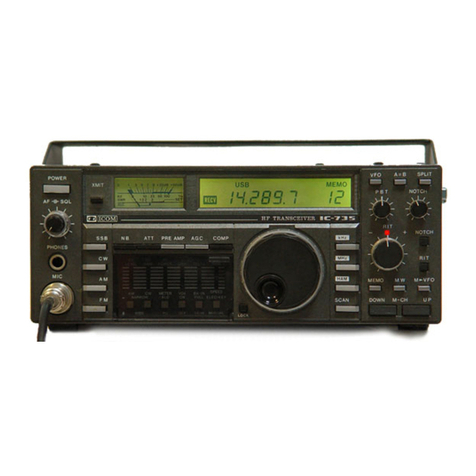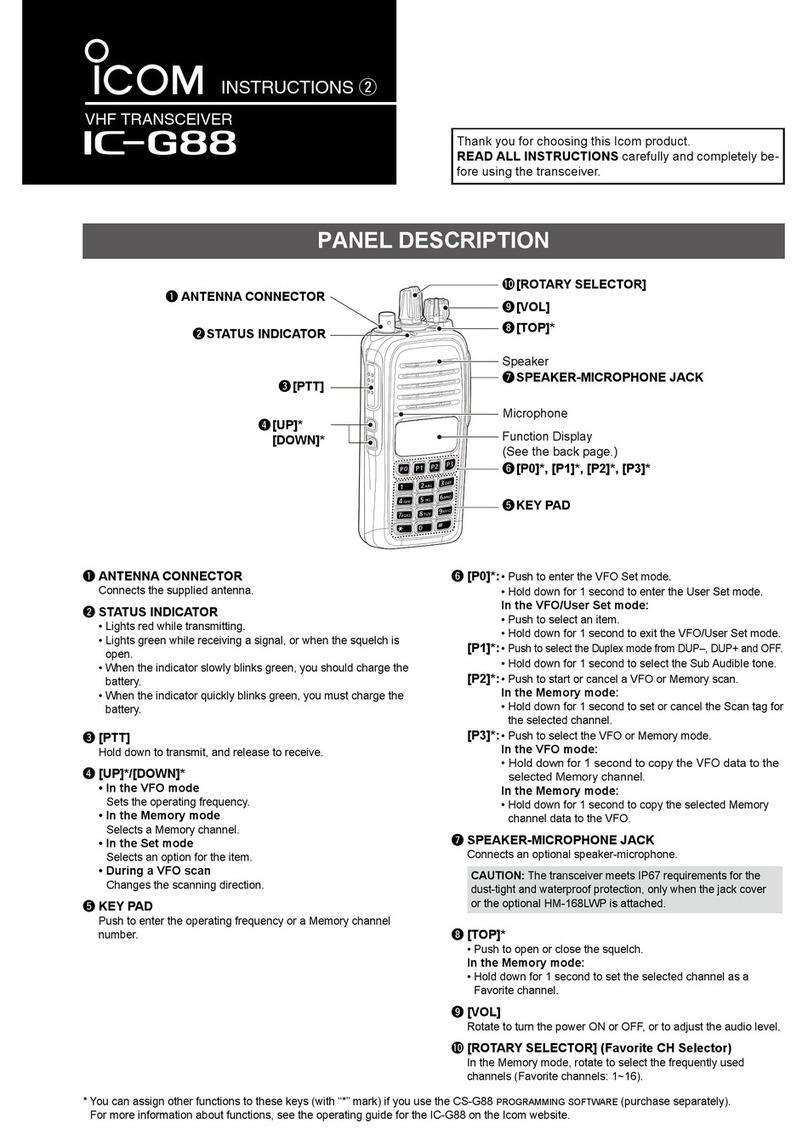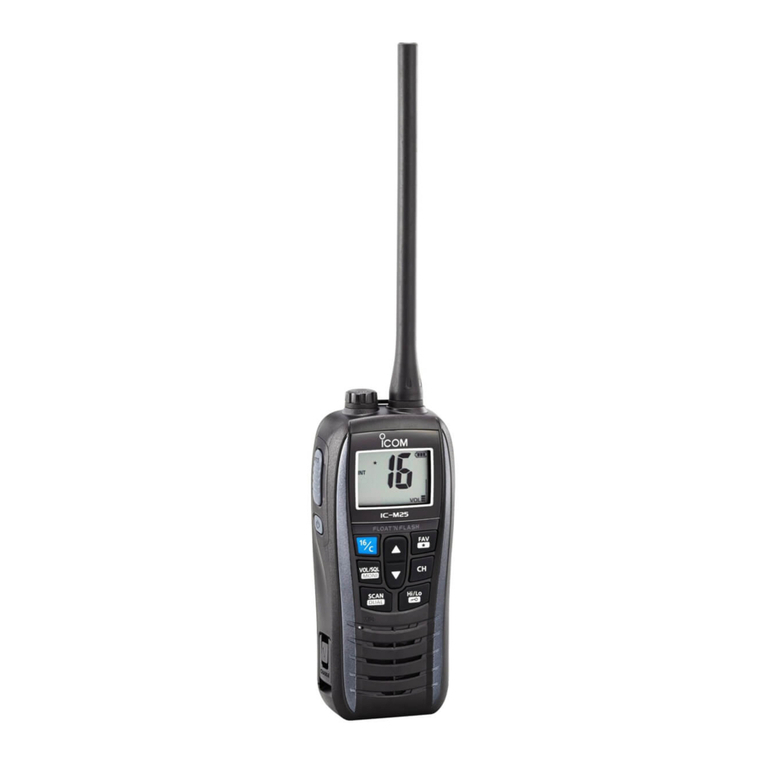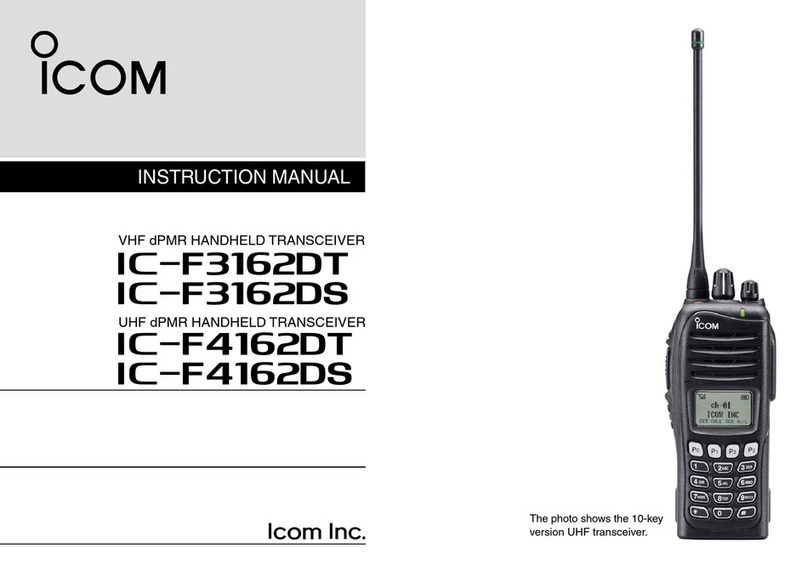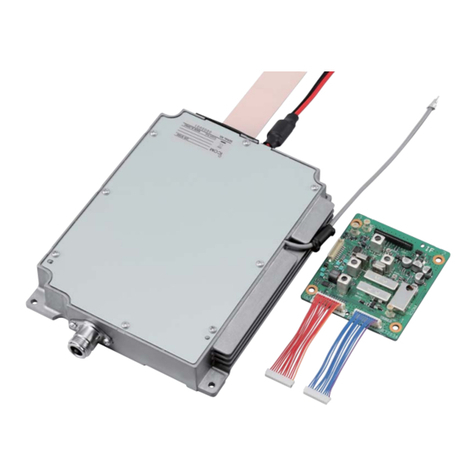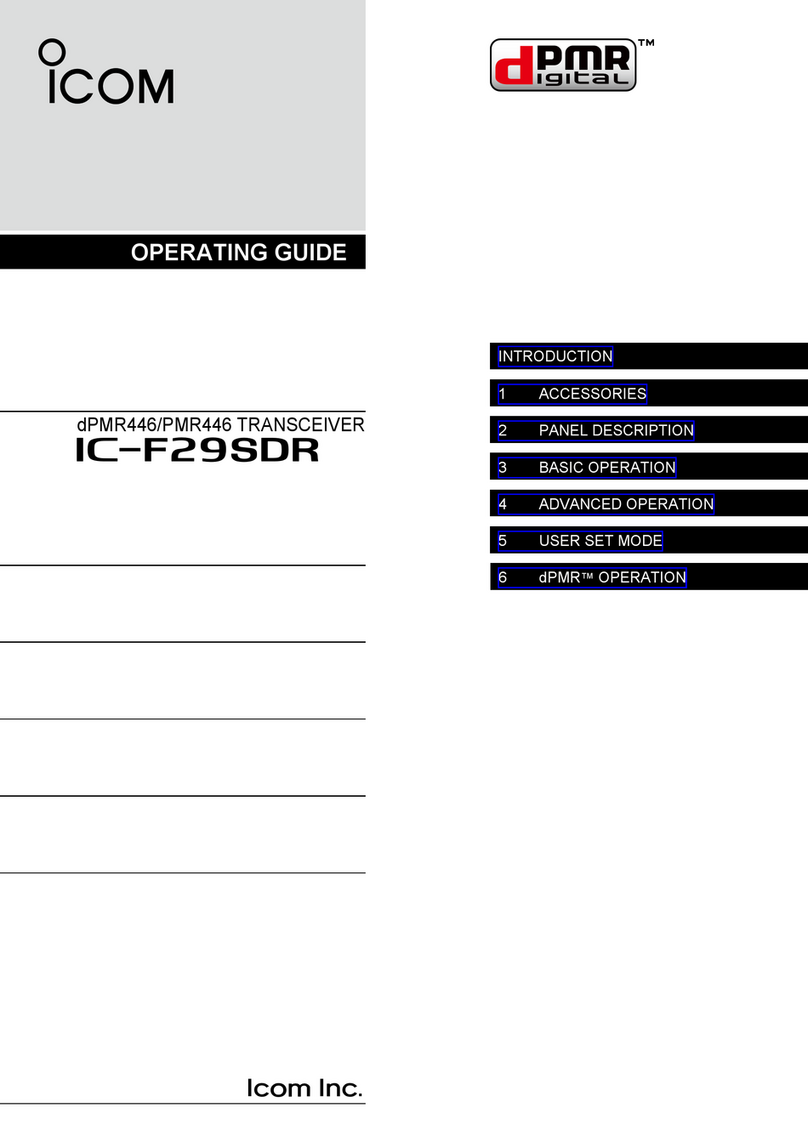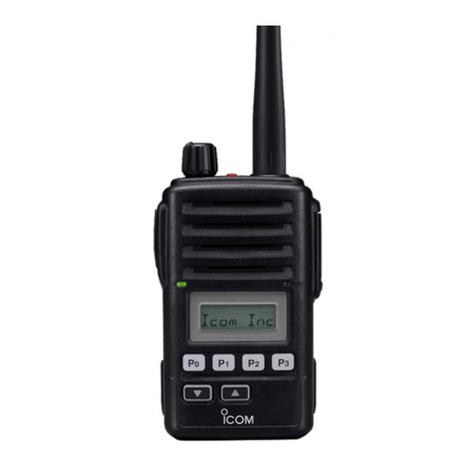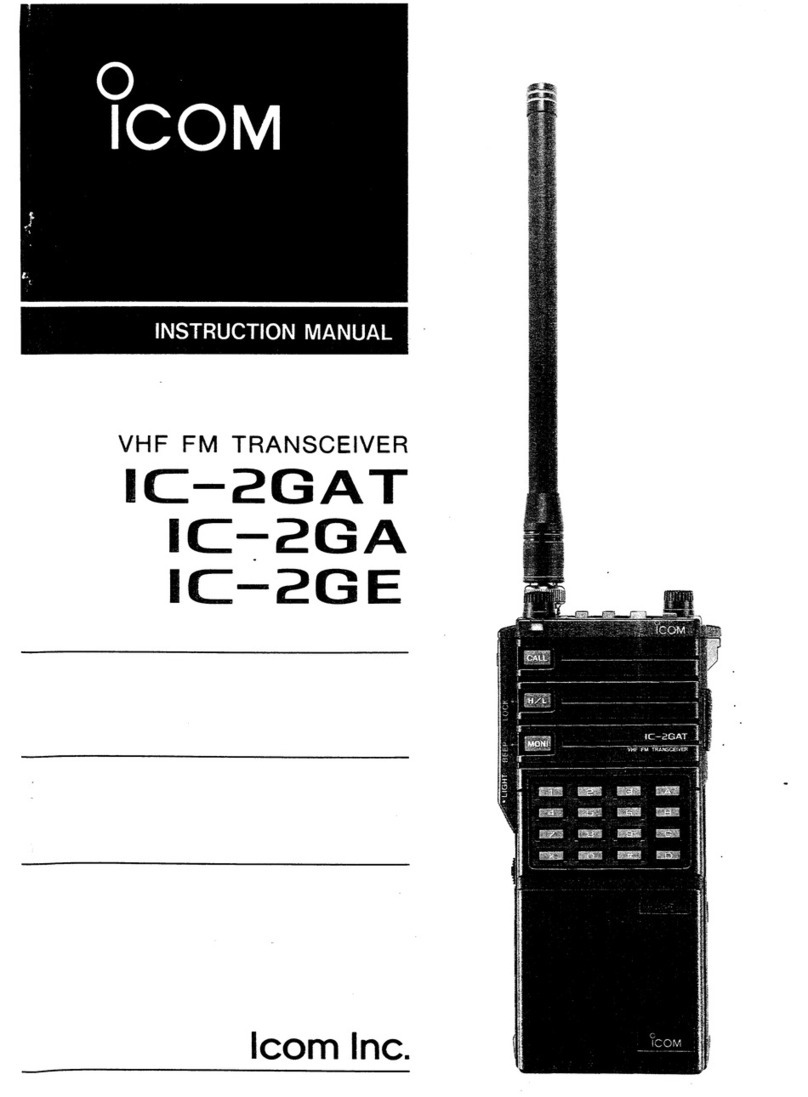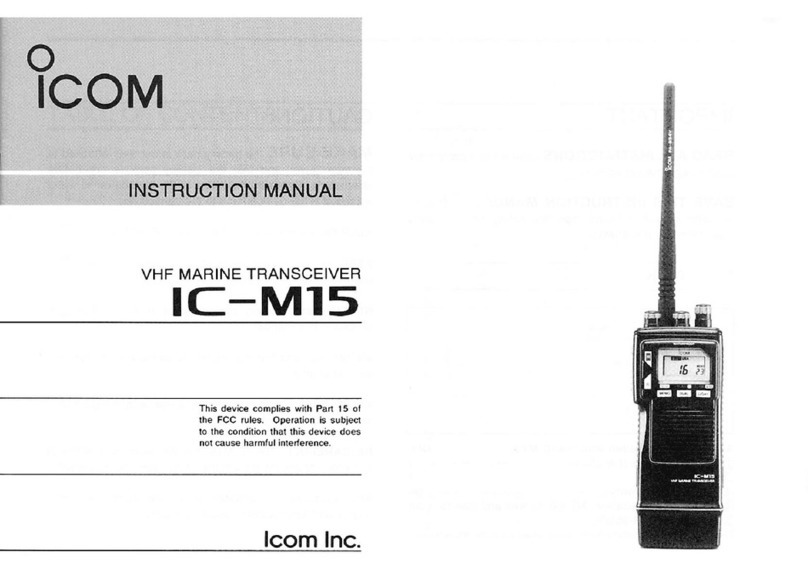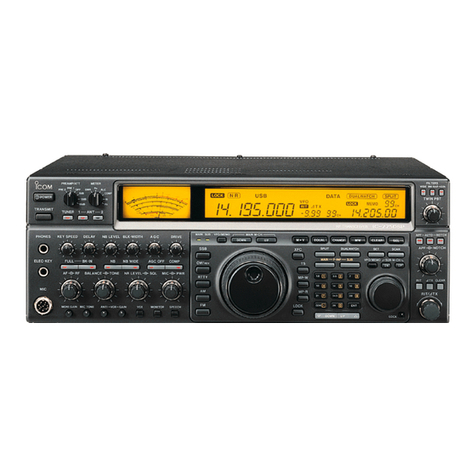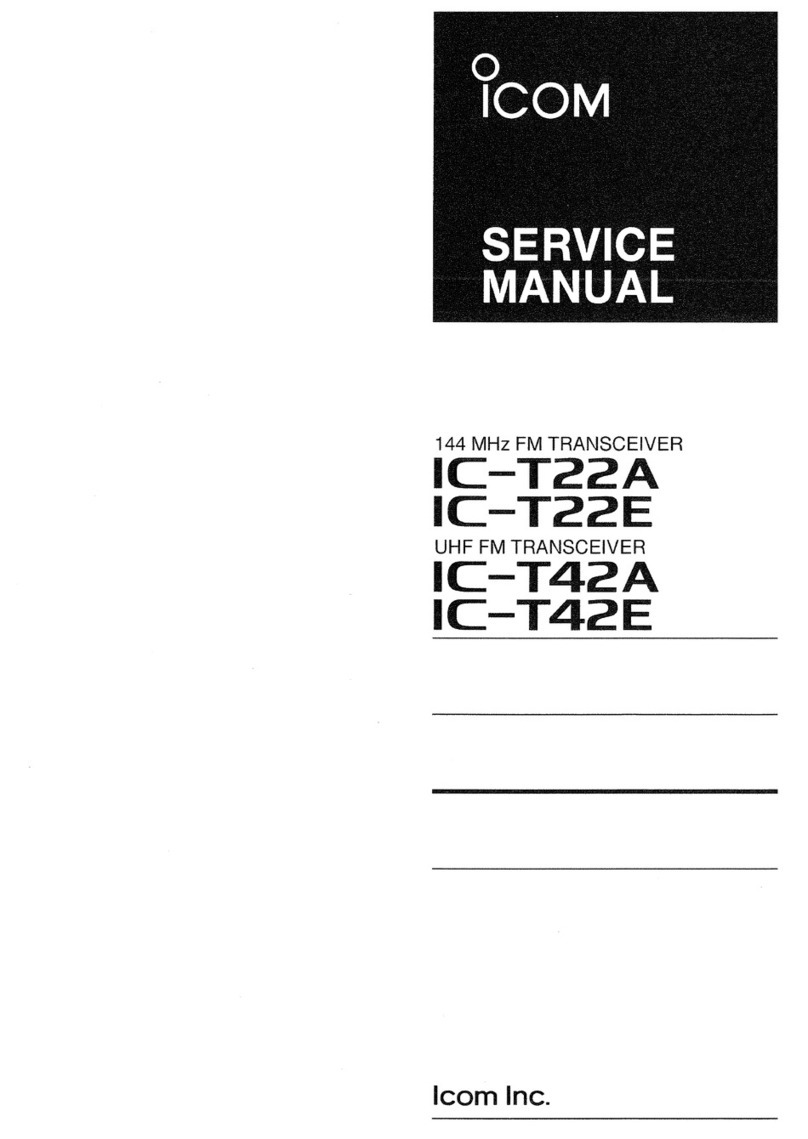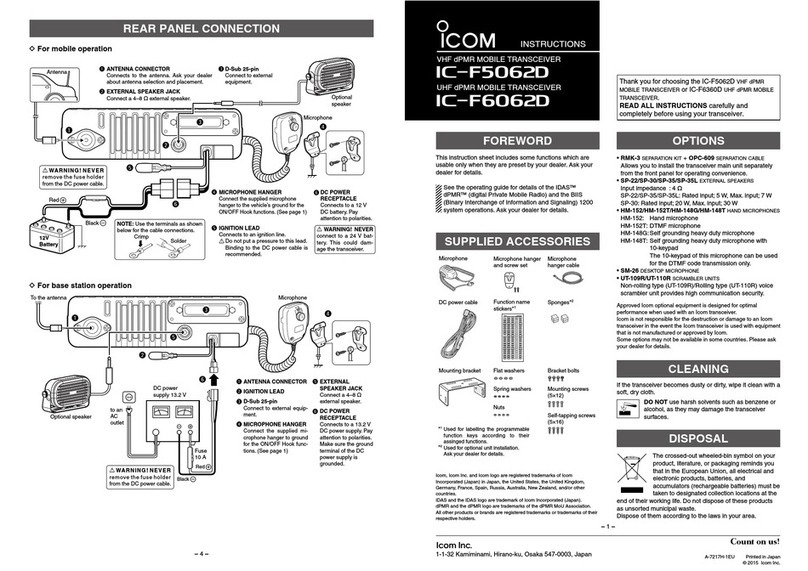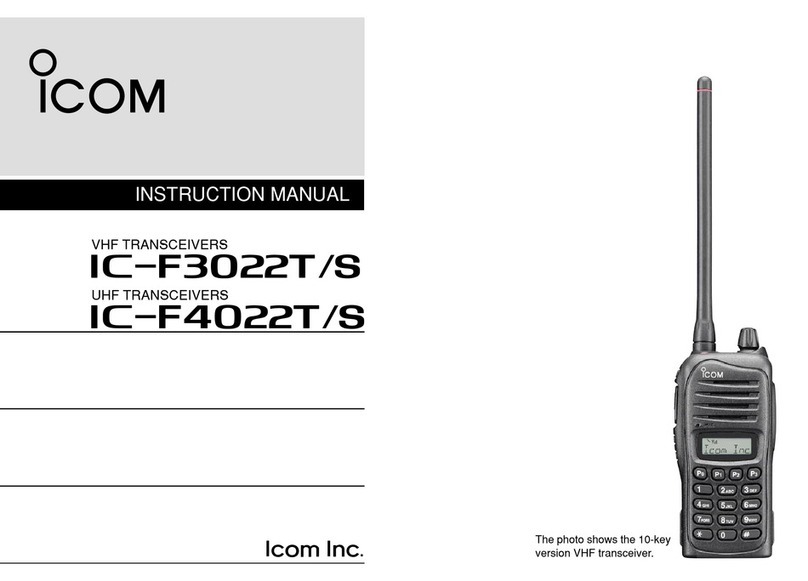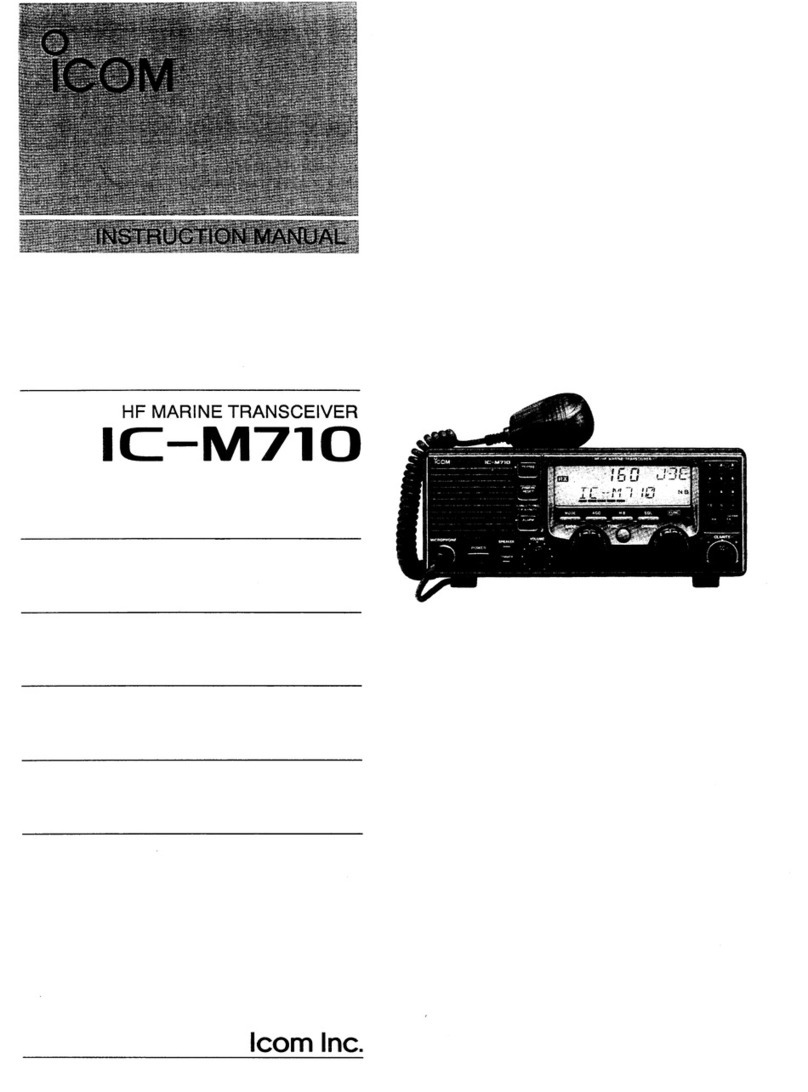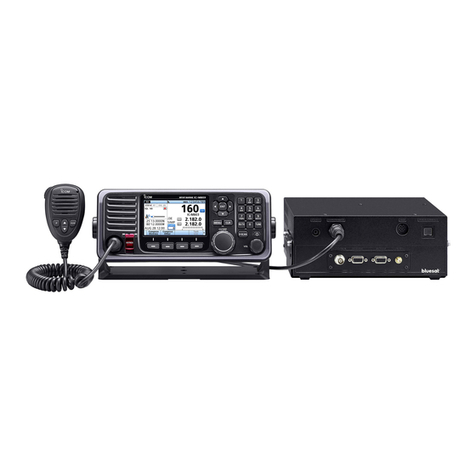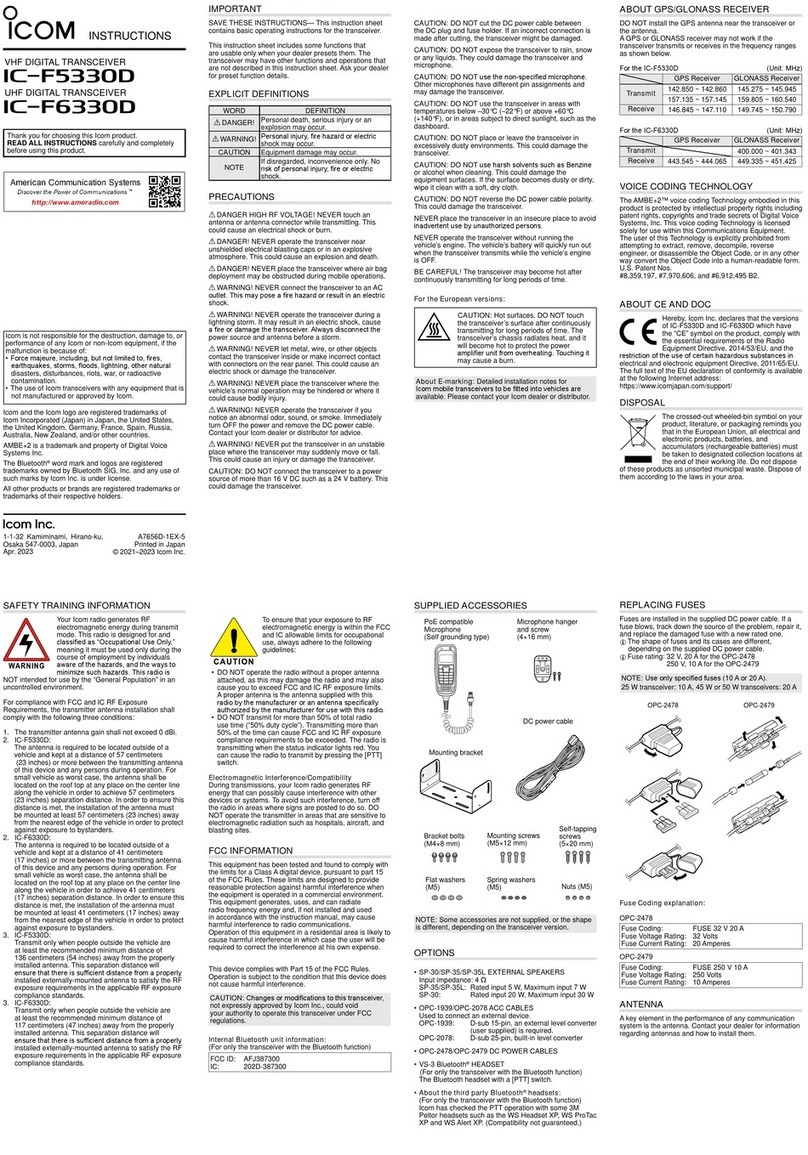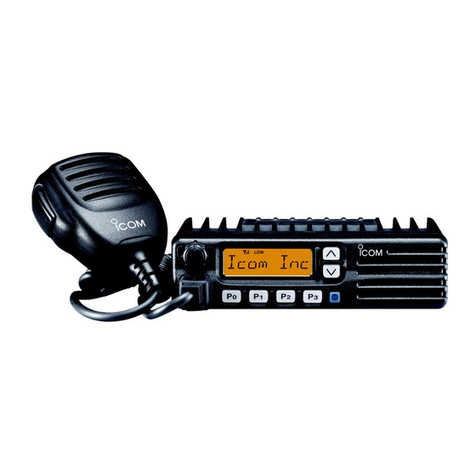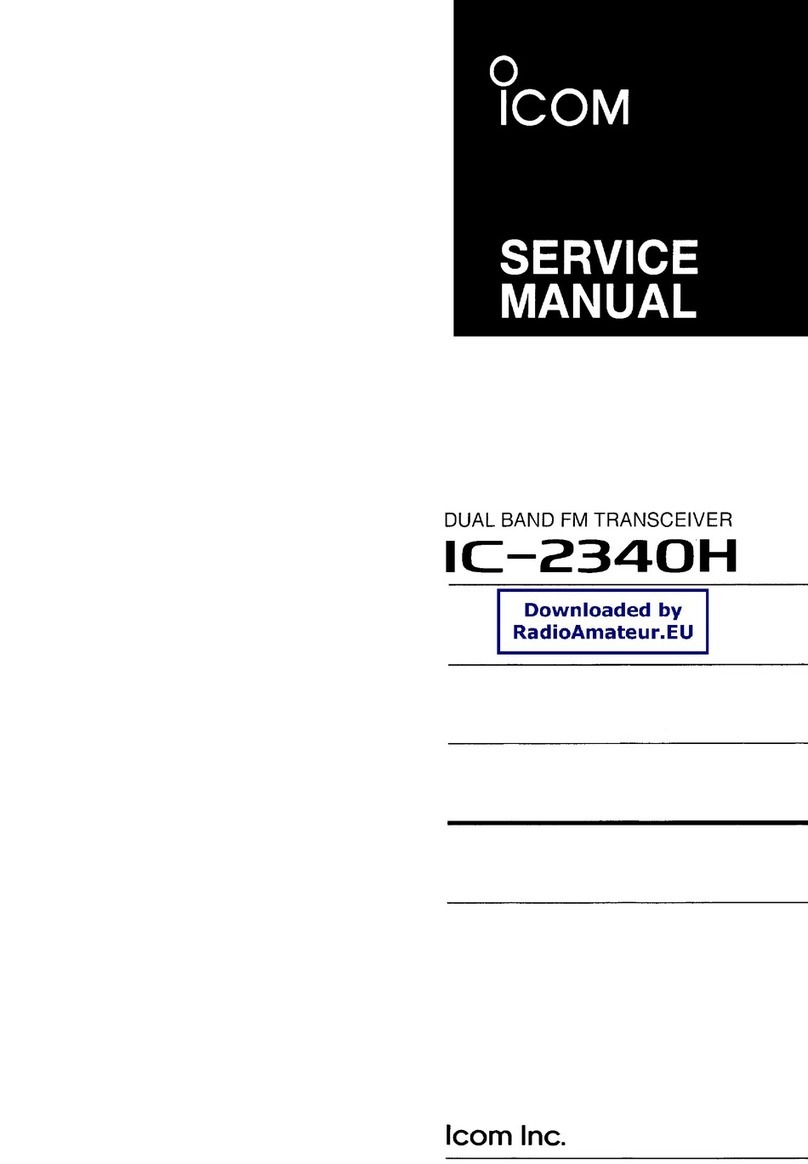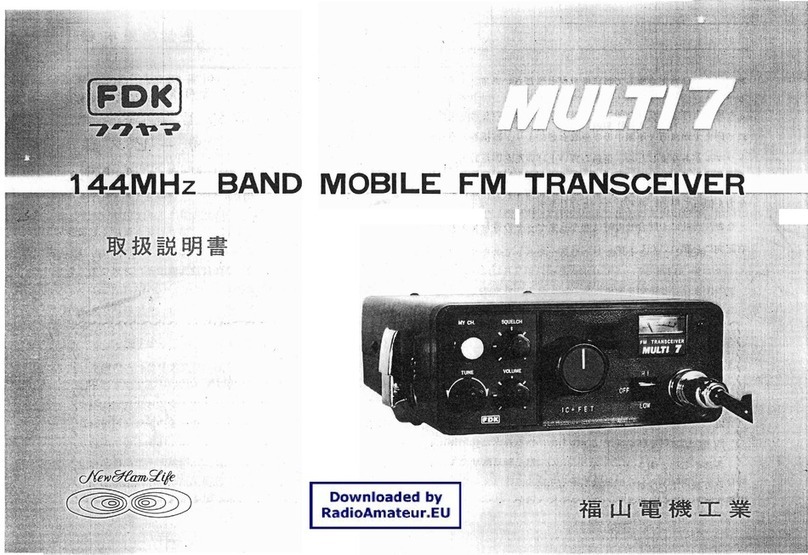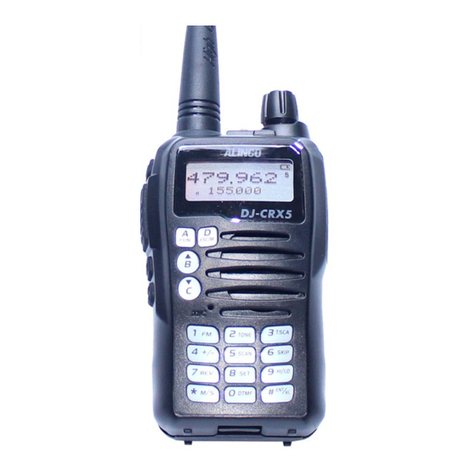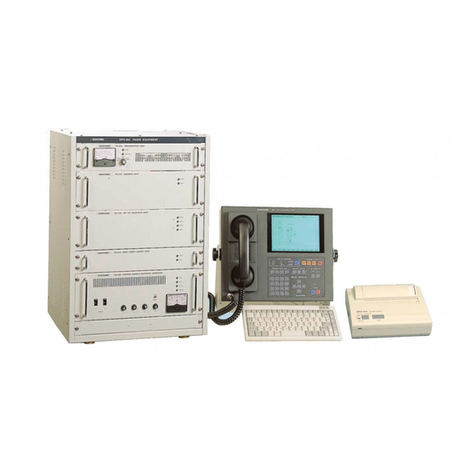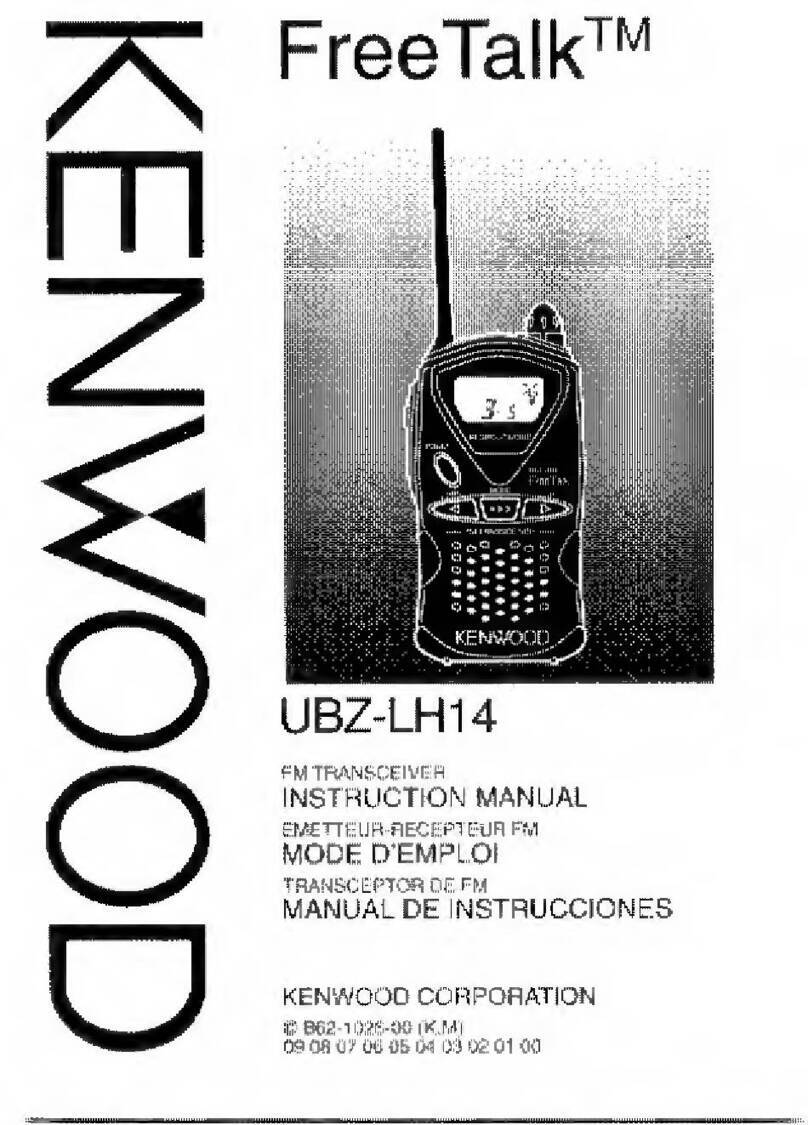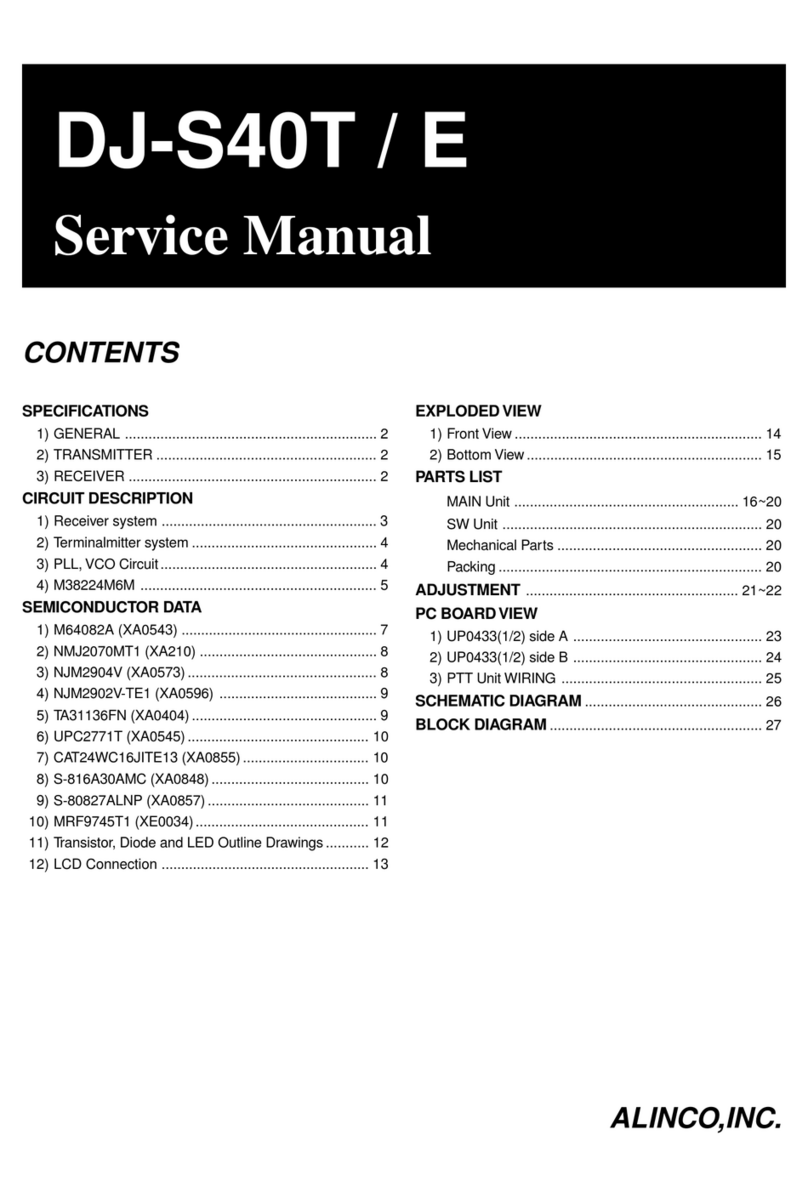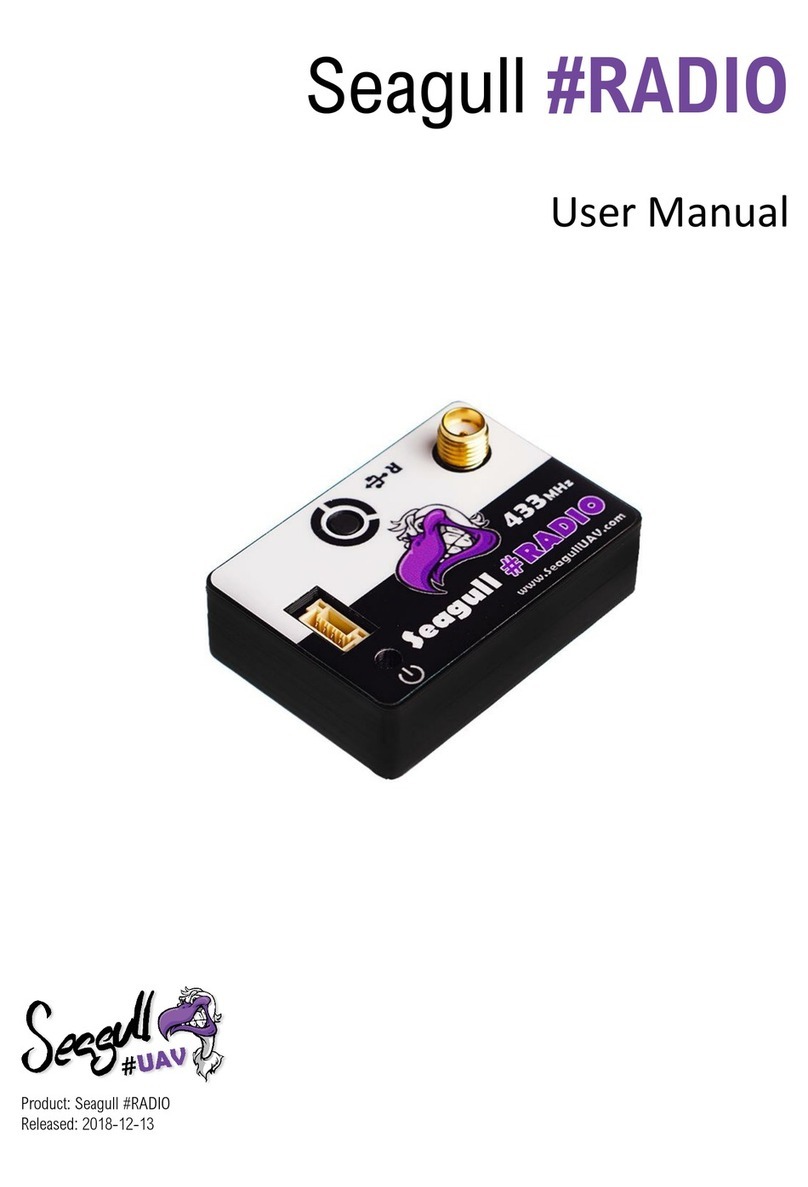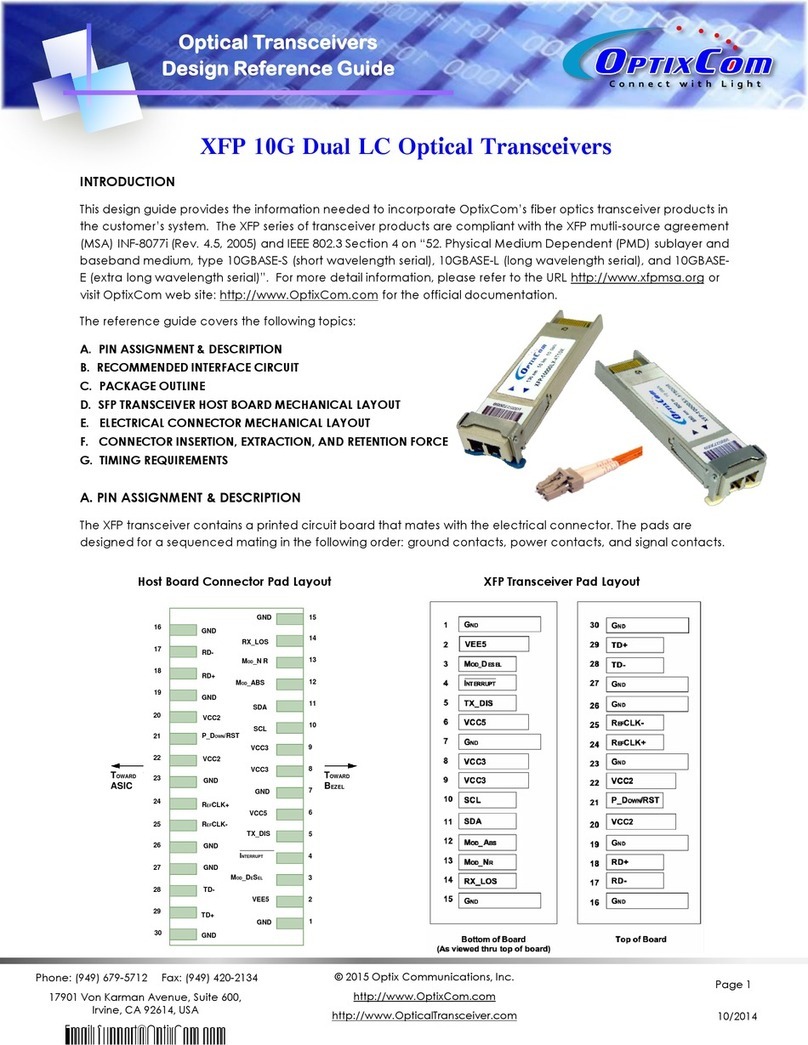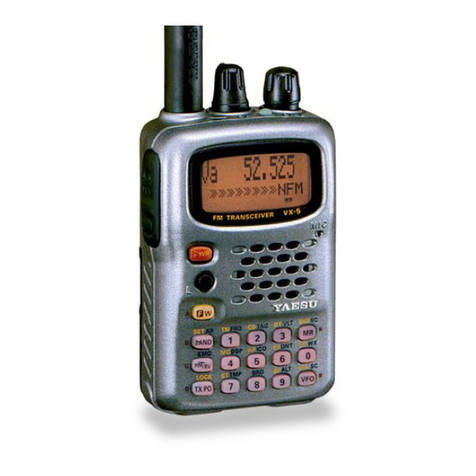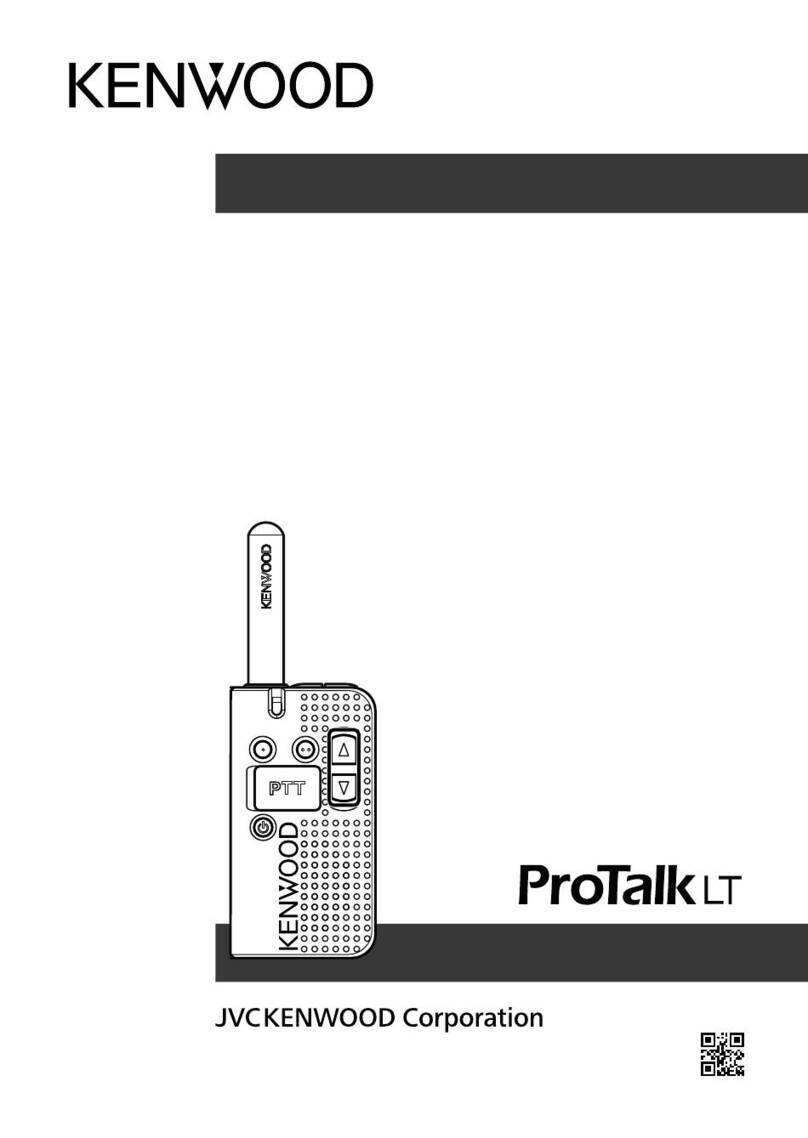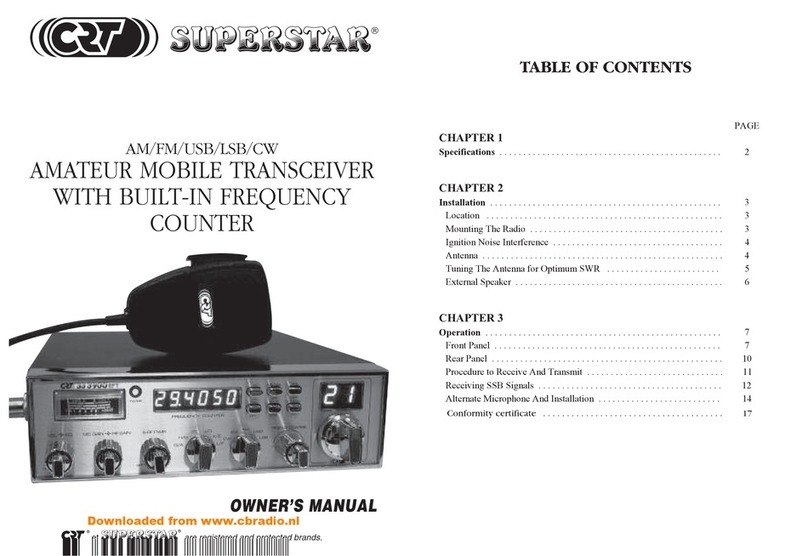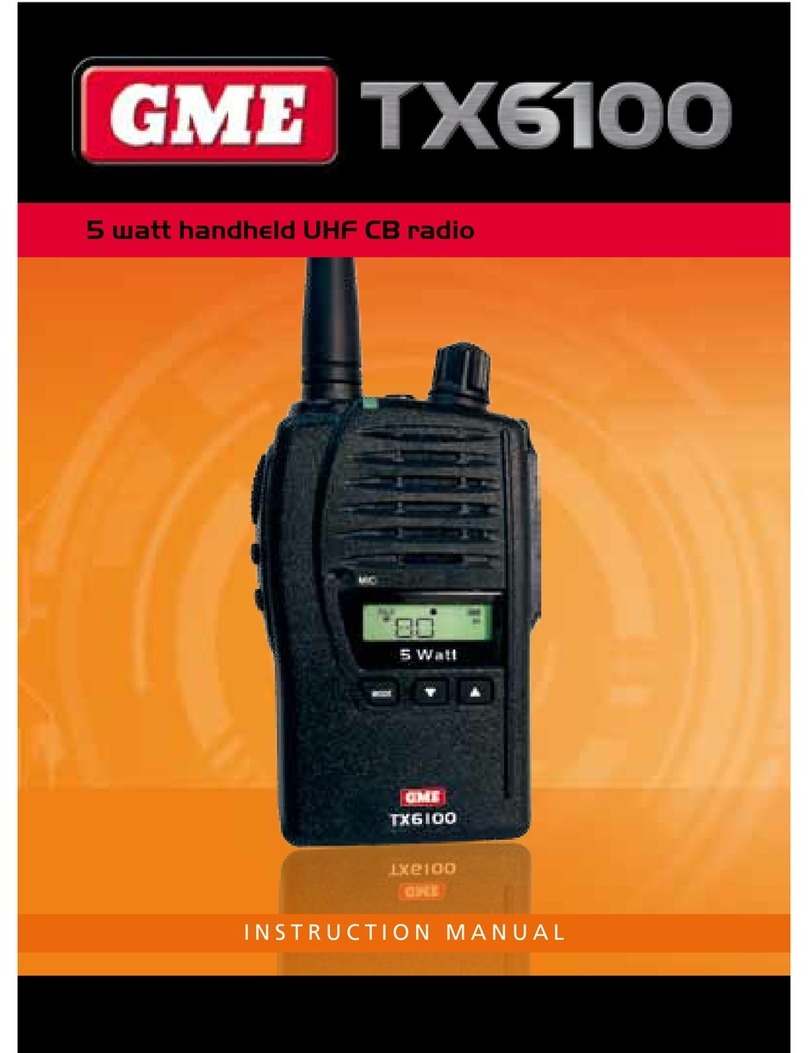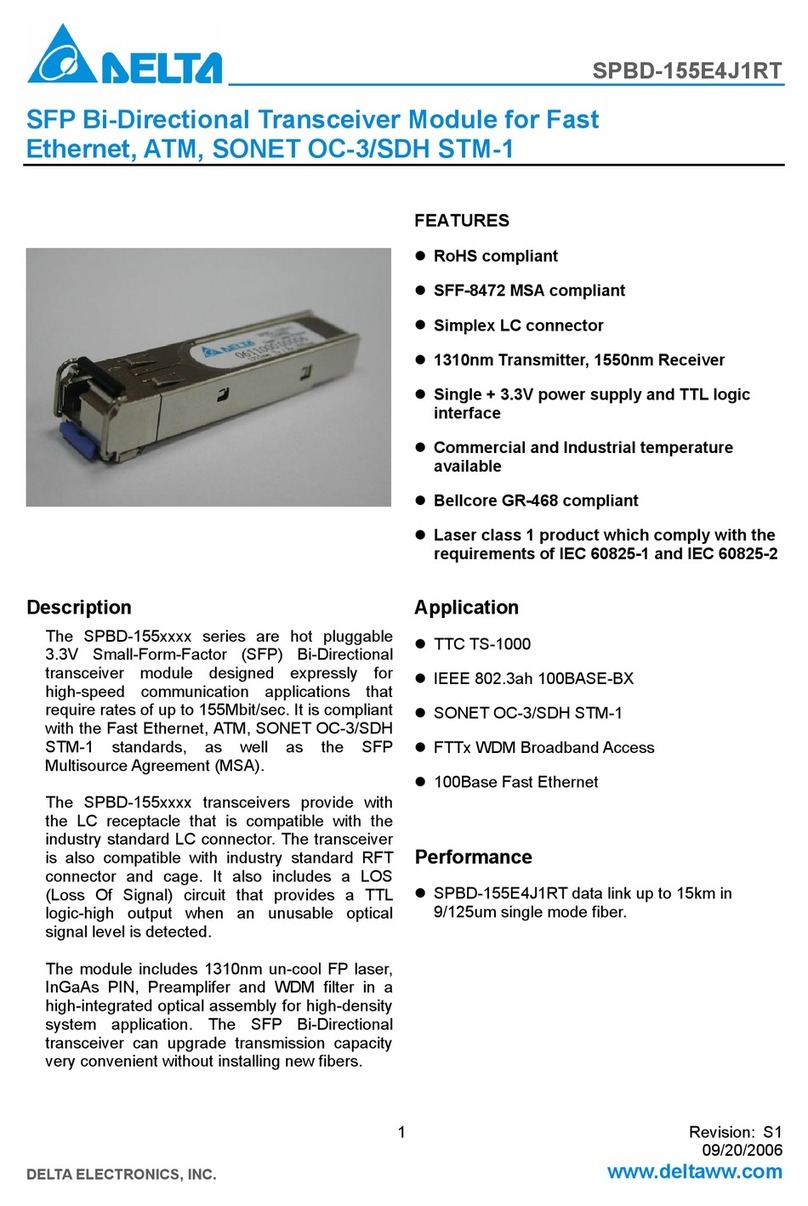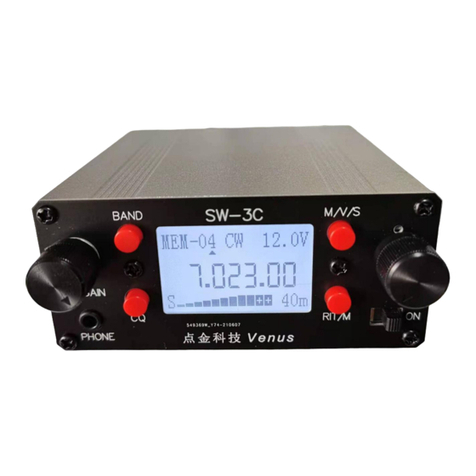Icom IC-F3210D Series User manual

S-15006XZ-C1
July 2013
VHF DIGITAL TRANSCEIVERS

This service manual describes the latest technical informa-
tion for the IC-F3210D VHF DIGITAL TRANSCEIVERS, at the
time of publication.
NEVER connect the transceiver to an AC outlet or to a DC
power supply that uses more than the specified voltage. This
will ruin the transceiver.
DO NOT expose the transceiver to rain, snow or liquids.
DO NOT reverse the polarities of the power supply when con-
necting the transceiver.
DO NOT apply an RF signal of more than 20 dBm (100 mW) to
the antenna connector. This could damage the transceiver’s
front-end.
To upgrade quality, any electrical or mechanical parts
and internal circuits are subject to change without notice
or obligation.
MODEL VERSION CHANNEL
SPACING AC Adapter
IC-F3210D USA-01 6.25/12.5 BC-123SA
EXP-01 6.25/12.5/25 BC-123SE
Be sure to include the following four points when ordering
replacement parts:
1. 10-digit Icom part number
2. Component name
3. Equipment model name and unit name
4. Quantity required
<ORDER EXAMPLE>
1110003491 S.IC TA31136FNG IC-F3210D MAIN UNIT 5 pieces
8820001210 Screw 2438 screw IC-F3210D Top cover 10 pieces
Addresses are provided on the inside back cover for your
convenience.
ORDERING PARTS
1. Make sure that the problem is internal before dis-assem-
bling the transceiver.
2. DO NOT open the transceiver until the transceiver is dis-
connected from its power source.
3. DO NOT force any of the variable components. Turn them
slowly and smoothly.
4. DO NOT short any circuits or electronic parts. An insulated
tuning tool MUST be used for all adjustments.
5. DO NOT keep power ON for a long time when the trans-
ceiver is defective.
6. DO NOT transmit power into a Standard Signal Generator
or a Sweep Generator.
7. ALWAYS connect a 30/50 dB to 40/60 dB attenuator be-
tween the transceiver and a Deviation Meter or Spectrum
Analyzer, when using such test equipment.
8. READ the instructions of the test equipment thoroughly
before connecting it to the transceiver.
REPAIR NOTES
INTRODUCTION
CAUTION
Icom, Icom Inc. and the Icom logo are registered trademarks of Icom Incorporated (Japan) in Japan, the United States, the
United Kingdom, Germany, France, Spain, Russia and/or other countries.

TABLE OF CONTENTS
SECTION 1 SPECIFICATIONS
SECTION 2 INSIDE VIEWS
SECTION 3 DISASSEMBLY INSTRUCTION
SECTION 4 CIRCUIT DESCRIPITON
4-1 RECEIVER CIRCUITS...................................................................................... 4-1
4-2 TRANSMITTER CIRCUITS............................................................................... 4-2
4-3 FREQUENCY SYNTHESIZER CIRCUITS ....................................................... 4-4
4-4 VOLTAGE BLOCK DIAGRAM ........................................................................... 4-4
4-5 PORT ALLOCATIONS ...................................................................................... 4-5
SECTION 5 ADJUSTMENT PROCEDURES
5-1 PREPARATION ................................................................................................. 5-1
5-2 FREQUENCY ADJUSTMENT .......................................................................... 5-3
5-3 TRANSMIT ADJUSTMENT............................................................................... 5-4
5-4 RECEIVE ADJUSTMENT ................................................................................. 5-5
SECTION 6 PARTS LIST
SECTION 7 MECHANICAL PARTS
SECTION 8 BOARD LAYOUTS
SECTION 9 BLOCK DIAGRAM
SECTION 10 VOLTAGE DIAGRAM

1 - 1
SECTION 1
.
SPECIFICATIONS
MGENERAL
Frequency range 136–174 MHz
Number of conventional channels 16
Type of emission Wide* 16K0F3E (25.0 kHz)
Narrow 11K0F3E (15.0 kHz)
8K50F3E (12.5 kHz)
Digital 4K00F1E, D (6.25 kHz)
Antenna impedance 50 Ω(nominal)
Operating temperature range –30˚C to +60˚C (–22˚F to +140˚F)
Power supply voltage Specified Icom's battery packs only (7.5 V DC; negative ground)
Current drain (approximately) Receiving 90 mA (stand-by)
400 mA (maximum audio, with internal speaker)
Transmitting 1.3 A (at 5 W)
Dimensions
(with BP-265)
58.0(W)×111.5(H)×36.5(D) mm; 2.3(W) × 4.4(H) × 1.4(D) in
Weight (approximately) 150 g; 5.3 oz.
320 g; 11.3 oz. (including MB-124, BP-265 and FA-SC55V)
* ; For all models except [USA].

1 - 2
MTRANSMITTER
Output power 5 W
Modulation Variable reactance frequency modulation
Maximum frequency deviation Narrow ±2.5 kHz
Wide* ±5.0 kHz
Frequency error ±1.0 ppm
Spurious emissions 70 dB minimum, 75 dB typical
Adjacent channel power Narrow 60 dB minimum, 71 dB typical
Wide* 70 dB minimum, 75 dB typical
Digital 60 dB minimum, 65 dB typical
Audio harmonic distortion
(at AF 1 kHz 40% deviation)
Narrow 0.8% typical
Wide* 0.5% typical
FSK error 5% maximum, 2% typical
FM hum and Noise
(without CCITT Filter)
Narrow 34 dB minimum, 46 dB typical
Wide* 40 dB minimum, 52 dB typical
Limiting charact of modulator 60–100% of maximum deviation
Input impedance (MIC) 2.2 kΩ
MRECEIVER
Sensitivity 0.23 µV typical at 12 dB SINAD
–8 dBµ (EMF) typical at 5% BER
Squelch sensitivity (at threshold) 0.22 µV typical
Intermediate frequency 1st IF; 46.35 MHz, 2nd IF; 450 kHz
Adjacent channel selectivity Narrow 60 dB minimum, 71 dB typical
Wide* 70 dB minimum, 77 dB typical
Digital 50 dB minimum, 58 dB typical
Spurious response 70 dB minimum, 91 dB typical
Intermodulation Narrow
Wide*
70 dB minimum, 75 dB typical
Digital 65 dB minimum, 70 dB typical
FM hum and Noise
(without CCITT Filter)
Narrow
Wide*
34 dB minimum, 42 dB typical
40 dB minimum, 48 dB typical
Audio output power 0.8 W typical at 5% distortion with 12 Ωload (internal speaker)
0.4 W typical at 5% distortion With 8 Ω(external speaker)
Audio output impedance 8 Ω
* ; For all models except [USA].
Measurements made in accordance with TIA-603 and EN301 116.
All stated specifications are subject to change without notice or obligation.

2 - 1
SECTION 2
.
INSIDE VIEWS
• MAIN UNIT
(TOP VIEW)
MIC/AF LINE SW
(IC52)
VCO
5 V REGULATOR
(IC54)
AMP
(IC58)
PLL IC
(IC4)
CPU CLOCK
(X51)
APC AMP
(IC1)
TCXO
(X2)
RESET IC
(IC53)
3.3 V REGULATOR
(IC65)
2ND IF FILTER (For wide)
(FI3)
1ST IF FILTER
(FI2)
DISCRIMINATOR
(X1)
2ND IF FILTER (For narrow)
(FI4)
2ND IF FILTER (For digital)
(FI5)

2 - 2
• MAIN UNIT
(BOTTOM VIEW)
CLOCK AMP
(IC905)
AMP
(IC5)
PWR CTRL
(Q64)
DRIVE AMP
(Q2)
TX POWER AMP
(Q1)
PRE-DRIVE AMP
(Q3)
RF AMP
(Q22)
AF AMP
(IC55)
IF DEMODULATOR IC
(IC3)
1ST IF FILTER
(FI1)
R5 LINE REGULATOR
(Q72)
AF CUSTOM IC
(IC2)
RIPPLE FILTER
(Q15)
1ST IF MIXER
(Q23)
AF POWER AMP
CONTROLLER
(Q63)
CPU
(IC51)
PLL BUFFER
(Q9)
POWER LINE SW
(Q92)

3 - 1
SECTION 3
.
DISASSEMBLY INSTRUCTION
BE CAREFUL to not pull out the speaker wire when
separating the CHASSIS and the FRONT PANEL.
For easy separation of the CHASSIS
Use a suction lifter to lift the bottom of the CHASSIS up.
1. REMOVING THE CHASSIS
1) Remove the ANT connector nut and 2 knobs.
2. REMOVING THE MAIN UNIT
1) Remove the 9 screws and the side plate from the
MAIN UNIT.
2) Unsolder the 2 points shown, and then remove the
MAIN UNIT.
2) Remove 2 screws from the bottom of the CHASSIS.
3) Lift the bottom of the CHASSIS up in the direction
of the arrow.
4)
CAREFULLY lift the chassis out of the FRONT PANEL
and turn it over in order to unplug the speaker wire.
(Continued to the right above)
5) Remove the seals and nuts from the CHASSIS.
ANT CONNECTOR NUT
KNOB
FRONT PANEL
Remove with;
“ICOM Driver (K)”
(8960000110)
FRONT PANEL
CHASSIS
SCREW×2
SPEAKER
WIRE
CHASSIS
FRONT PANEL
TOP SEAL
NUT×2 SIDE SEAL
CHASSIS
Remove with;
“ICOM Driver (AG)”
(8960000560)
UNSOLDER
Solder
remover
CHASSIS
SCREW×9
MAIN UNIT
MAIN UNIT
SIDE PLATE
Suction lifter
Suction lifter
• Part name : EA950R-2
• Manufacture : ESCO CO.LTD

4 - 1
SECTION 4
.
CIRCUIT DESCRIPTION
• RF CIRCUIT
• 1ST IF CIRCUIT
• 2ND IF AND DEMODULATOR CIRCUITS
4-1 RECEIVER CIRCUITS
RF CIRCUIT
The RX signal from the antenna is passed through the LPF
(L1–L3, C2–C7, C24, and C37) and antenna SW (D1, D22,
D23), then filtered by the 2-staged tuned BPF (D24 and
D26) to eliminate unwanted out-of-band signals. The filtered
RX signal is amplified by the RF AMP (Q22), and filtered by
another 2-staged tuned BPF (D28) to obtain a good image
response, then applied to the 1st IF circuit.
The BPFs are tuned to the RX frequency by applying ad-
equate tuning voltages: “T1” and “T2” to the variable capaci-
tors.
1ST IF CIRCUIT
The RX signal from the RF circuit is applied to the 1st IF
mixer (Q23) and mixed with the 1st LO signal from the RX
VCO, resulting in the 46.35 MHz 1st IF signal. The 1st IF sig-
nal is passed through the IF SWs (D31–D34) and the crystal
filter (FI1: analog mode, FI2: digital mode) to be filtered, am-
plified by the 1st IF AMP (Q24), then applied to the 2nd IF
circuit.
• WHILE OPERATING IN THE ANALOG MODE
The 2nd IF signal is filtered by the 2nd IF filter (FI3: wide
mode) or filters (FI3 and FI4: narrow) to eliminate unwanted
signals. It is amplified by the 2nd IF AMP, and then demodu-
lated by the detector circuit, which employs the discriminator
(X1) as the phase shifter.
The demodulated AF signal, output from pin 9, is applied to
the linear codec inside IC2 (a custom AF IC). The AF signal
is encoded into a digital signal, then demodulated by DSP
(IC903). The demodulated signal is then applied back to the
linear codec to be decoded into an analog audio signal.
• WHILE OPERATING IN THE DIGITAL MODE
The 2nd IF signal is filtered by the 2nd IF filters (FI3 and FI4)
to eliminate unwanted signals, and applied to the IF AMP
(IC5) through the buffer (Q28). The amplified 2nd IF signal is
passed through the ceramic filter (FI5), and then applied to
the A/D converter (IC901) to be encoded into a digital signal.
The digital signal is demodulated by the DSP (IC903), and
then applied to the linear codec
(
inside IC2) to be decoded
into an analog audio signal.
The AF signal is applied to the RX AF circuit.
LPF
ANT
SW
D1,D22,D23
RF
AMP
Q22
BPF
D28 D24,D26
BPF
T2 T1
From the TX circuits
To the 1st IF circuits
ANT
LO
SW
D5,D6
D31,D32D33,D34
Q23
BPF
XTAL
FI1
IF
AMP
Q24
BUFF
Q8
BUFF
Q10
ATT
IF SW
IF SW
RX VCO
To the TX circuit
From the RF circuit
To the 2nd
IF circuit
46.35MHz
BPF
XTAL
FI2
46.35MHz
1st IF mixer
W/N
SW
D38,D39
BPF
CERAMIC
FI3
BPF
CERAMIC
FI4
W/N
SW
D36,D37
IF IC
From the 1st IF
circuit
(Digitalpath)
IC3
450kHz
450kHz
VOL1
AMP ALC
AMP
VOL1
AMP
LPF
BUFF
VOL1
W/N SW
Q901
BUFF
VOL1
LIMIT AMP
DET
D53
W/N SW
BUFF
HPF
MOD
LINE
CTRL
VOL1
R89
LINEAR
REF
DET
AFVO
BEEP
MOD
MICI TX/RX
SW
DMO
IC2
BAL
CODEC
DAFO
SQIN
VCON
DISC
VOXV
T1
LVA
T2
NWC
X1
RSSI NOISSQIN
DET
SSO,SSK,DAST
X3
Q26
BPF
X2
TCXO
15.3MHz
45.9MHz
CERAMIC
BPF
FI5
DIF
AMP
IC5
BUFF
Q28
A/D
IC901
DSP
IC903
2ND IF AND DEMODULATOR CIRCUITS
The signal from the 1st IF circuits is applied to the IF demod-
ulator IC (IC3) which contains the 2nd IF mixer, 2nd IF AMP,
FM detector, squelch circuit and AF AMP in its package.
The 1st IF signal is applied to the 2nd IF mixer and mixed
with the 2nd LO signal resulting in the 450 kHz 2nd IF signal.
The 2nd LO signal is generated by tripling the 15.3 MHz
reference frequency signal generated by the reference fre-
quency oscillator (TCXO; X2).

4 - 2
• RX AF CIRCUIT
• SQUELCH CIRCUIT
• TX AF CIRCUITS
4-2 TRANSMITTER CIRCUITS
TX AF CIRCUITS
The audio signal from the internal or external microphone
(MIC signal) is applied to IC2 (pin 13). The MIC signal is
amplified by the MIC AMP (inside IC2) and then output from
pin 11.
• WHILE OPERATING IN THE ANALOG MODE
The MIC signal is passed through the HPF (IC2, pin 1), which
attenuates frequencies 300 Hz and below, and then applied
to the limiter AMP (pin 4 of IC2).
The amplitude-limited MIC
signal is applied to IC2.
The MIC signal is converted into a digital audio signal by the
linear codec (inside IC2), processed by the DSP (IC903),
and then converted into an analog baseband signal (modu-
lation signal).
• WHILE OPERATING IN THE DIGITAL MODE
The MIC signal is applied to the ALC (IC2, pin10) which
keeps the signal level fixed.
The level-adjusted MIC signal is
applied to the linear codec
(
inside IC2) through the MIC line SW (inside IC2).
The MIC signal is converted into a digital audio signal by the
linear codec (inside IC2), processed by the DSP (IC903),
and then converted into the digital baseband signal (modula-
tion signal).
The signal from the linear codec (inside IC2) is passed
through the LPF (inside IC2), and then applied to the D/A
converter (inside IC2)
which adjusts its level (=deviation)
.
The level-adjusted modulation signal is applied to the modu-
lation circuit.
AF
AM P
AF
AMP
IC55 J52
SP1
AF
AM P
J53
Int.speaker
Ext.speaker
1
2
IC58
AFON
AFO
From the IF IC
AFVO
Electronic
volume
IC2
DAC Noise
AMP
Noise filter
From IF IC
(IC3, Pin16)
To RX AF circuits
Noise
detector
Com-
parator
NOISE SQUELCH DIAGRAM
“NOIS”
IC57
IC3
14
8
7
13
15
VOL1
R89
AMP ALC
AMP
VOL1
AMP
LPF
BUFF
MC51
J51
VOL1
W/N SW
Q901
BUFF
LIMIT AMP
DET
D53
W/N SW
BUFF
IC60
NJM13403V
HPF
MOD
LINE
CTRL
VOL1
R89
DSP
IC903
LINEAR
REF
DET
AFVO
BEEP
MOD
TX/RX
SW
DMO
IC2
BAL
CODEC
DAFO
SQIN
VCON
DISC
VOXV
T1
LVA
T2
NWC
[Ext. MIC]
[Int. MIC]
To the modulation
circuit
SQUELCH CIRCUIT (Analog mode only)
The squelch circuit cuts off the AF output signals when no
RF signals are received. Detecting noise components in the
demodulated AF signals, the squelch circuit stops audio sig-
nals being heard.
A portion of the demodulated AF signal from the IF IC (IC3)
is passed through IC2 for level (=threshold) adjustment. The
level-adjusted AF signals are passed through the noise filter
(IC3, pins 7, 8 and R139–R142, C241–C243) to filter only
the noise components (approximately 30 kHz signals). The
noise components are rectified, resulting in a DC voltage
corresponding to the noise level.
If the noise level is higher than the preset one, the internal
comparator sets the “NOISE” signal to the CPU to “High,”
then the CPU turns the “AFON” signal which controls the AF
power AMP (IC55) to “Low,” to deactivate it.
RX AF CIRCUITS
The detected audio signals adjusted by the linear codec’s
electronic volume (inside IC2). The level-adjusted AF signal
is then amplified by the pre-AMP (IC58) and AF power AMP
(IC55).
The amplified AF signal is applied to the internal or external
speaker.

4 - 3
4-4 VOLTAGE DIAGRAMS
Voltage from the power supply is routed throughout the transceiver, through regulators and switches.
• TX AMPLIFIERS AND APC CIRCUITS
• FREQUENCY SYNTHESIZER CIRCUIT
MODULATION CIRCUIT
The modulation signal from the TX AF circuit is applied to
D15 of the TX VCO (Q14, D14–D17) to modulate it (FM for
the analog mode, 4FSK for the digital mode). The modulated
signal from the TX VCO is buffer-amplified by two buffers
(Q8, Q10), and applied to the TX AMP circuit through the LO
SW (D5, D6).
4-3
FREQUENCY SYNTHESIZER CIRCUIT
The RX VCO is composed of Q13, and D11–D13. The VCO
output signal is buffer-amplified by two buffers (Q8 and Q10)
and applied to the 1st IF mixer, through the LO SW (D6) and
the attenuator.
The TX VCO is composed of Q14 and D14–D17. The VCO
output signal is buffer-amplified by two buffers (Q8 and Q10)
and applied to the pre-driver (Q3), through the LO SW (D5)
and the LPF.
A portion of signal generated by each VCO is fed back to
the PLL IC (IC4, pin 17) through the buffer (Q9) and the LPF
(L46, C167–C169).
The applied VCO output signal is divided and phase-com-
pared with a 15.3 MHz reference frequency signal from the
TCXO (X2), which is also divided. The resulting signal is
output from the PLL IC (IC4), and DC-converted by the loop
filter, and then applied to the VCO as the lock voltage.
When the oscillation frequency drifts, its phase changes
from that of the reference frequency, causing a lock voltage
change to compensate for the drift in the VCO oscillating fre-
quency.
LO
SW
D5,D6
Q14,
D14,D16,D17
MODULATION
D15
BUFF
Q8
BUFF
Q10
TX VCO
From the TX AF circuits
To the TX AMP circuits
MOD
LPF
PWR
DET
D7,D8
MUTE
SW
Q6
ANT
SW
D1,D22,D23
PWR
AM P
Q1
APC
AMP
IC1
DRIVE
AM P
Q2
DRIVE
PRE
Q3
T1
TMUT
ANT
From the
TX VCO
To the RX circuits
TX AMPLIFIERS
The buffer amplified signal from the TX/RX SW (D5, D6) is
sequentially amplified by the pre-drive AMP (Q3), drive AMP
(Q2), and power AMP (Q1), to obtain TX power. The ampli-
fied TX signal is passed through the antenna SW (D1, D22,
and D23) and the LPF, which eliminates harmonics, and
then fed to the antenna.
APC CIRCUIT
D7 and D8 rectify a portion of the TX signal to direct current,
and the APC AMP (IC1) compares the voltage and the TX
power control reference voltage, “T1.” The resulting voltage
controls the gain of the power and drive AMPs to keep the
TX power constant.
• MODULATION CIRCUIT
LPF
LO
SW
D5,D6
Q13,D12
Q14,D16
FILTER
LOOP
PLL
IC
SO,SCL,PLST
IC
VCON
4
X3
Q26
Q23
To the TX AMPs
BPF
BUFF
Q8
BUFF
Q10
BUFF
Q9
X2
TCXO
LV
ADJ
D14
LV
ADJ
D11
ATT
IF IC
RX VCO
TX VCO
IC3
15.3MHz
45.9MHz
1st IF mixer
LV
LVA
S5
REG
Q71,Q86
REG
R5
Q72,Q87
REG
T5
Q73,Q88
F51
R1(CHASSIS)
12
BT1
REG
+5V
IC54
DC-DC
1.6V
IC900
DC-DC
3.3V
IC65
REG
+3.3V
Q90
,Q91
Q92,
Q93,
D59
POWER
SW LINE
FILTER
LINE
FILTER
LINE
FILTER
LIN E
FILTER
VCC
+5V
T5V Transmit circuits
Receive circuits
TX/RX common circuits
TX/RX common circuits
Logic circuits
R5V
S5V
TXC
RXC
S5C
VCC CPUV
CVDD_1.6 V
3.3V_VD D
+3.3V
+3.3V_A
+3.3V
PWON
POSWH
DVDD_3.3V
DSP
DSP flash
Liner codec
DSP reference voltage
CPUV

4 - 4
4-5 PORT ALLOCATIONS
• CPU (IC51)
BALL
No.
LINE
NAME DESCRIPTION I/O
A5 RXC Power supply switching control.
H= During receive or stand-by. O
A6 RMUTE
RX AF mute switch control.
L= During the squelch circuit is
activated.
O
A7 DMOSI Serial data to the DSP (IC903). O
A15 PWON Power supply switching control.
H= The transceiver's power is ON. O
B12 NOIS Noise level detect.
H= Squelch close I
B15 AFON AF power AMP control.
H= AF power AMP (IC55) is activated. O
C1,
C2
CBI2,
CBI0 [ROTARY SELECTOR] input. I
C5 TXC Power supply switching control.
H= While transmitting. O
C8 ESDA EEPROM (IC52) serial data. I/O
C13 POSW Power switch. (R424) I
C14 ADS
1st IF filters (FI1 and FI2) switching
control.
L= During digital mode.
O
C15 NWC Receive mode (narrow/wide) switching.
L= During narrow mode. O
D2,
D3
CBI3,
CBI1 [ROTARY SELECTOR] input. I
D6 DSCK DSP (IC903) clock. O
D8 ESCL EEPROM (IC52) clock. O
D13 DPDN DSP (IC903) power control.
H= DSP is inactivated O
D14 DRES DSP (IC903) reset.
L= Reset O
D15 CSFT Clock frequency shift.
H= Clock frequency is shifted. O
E13 RES CPU reset. I
H1 SIDE1 [UPPER] key input.
L= Pushed I
H2 SIDE2 [LOWER] key input.
L= Pushed I
J1 IPTT Internal [PTT] input.
L= Pushed. I
J2 XPTT External PTT input.
H= An external PTT is pushed. I
L1, L2 MCG0,
MCG1 MIC gain control. O
L12 TLED Busy LED (Red) control.
L= LED lights (While transmitting) O
L13 RLED Busy LED (Green) control.
L= LED lights. (While receiving a signal) O
L14 SSO Common serial data. O
L15 SCK Common clock. O
M1 TMUT Transmission mute.
L= TX inhibit. O
M2 ATX
Automatic TX control for VOX mode.
H= While MIC audio from the
connected headset is detected.
O
M8 BEEP Beep audio. (Square waves) O
M11 MDET External connection detect. I
M14 DAST AF CUSTOM IC (IC2) strobe.
H= Load enable. O
BALL
No.
LINE
NAME DESCRIPTION I/O
N11 VOXV Microphone input sensing voltage. I
N12 BATV Battery voltage sensing. I
N14 DMISO DSP (IC903) serial data. O
P4 PLSW PLL lock up time control.
L= Fast lock up O
P10 TEMP Temperature sensing voltage. I
P11 RSSI RSSI sensing voltage. I
P12 AFVI [VOLUME CONTROL] input. I
P15 DSS DSP (IC903) chip select. O
R3 S5C
Power supply line "S5C" switching
control.
H= Supplying current to the TX/RX
common circuits.
O
R4 PLST PLL strobe. O
R9 MDWN Man down detect.
L= While the transceiver is horizontal. I
R10 LVIN Lock voltage input. I

5 - 1
SECTION 5
.
ADJUSTMENT PROCEDURE
M JIG CABLE
EQUIPMENT GRADE AND RANGE EQUIPMENT GRADE AND RANGE
Cloning software CS-F3230D CLONING SOFTWARE
(Revision 1.0 or later) JIG cable Modified OPC–478UC
(See the illust below)
RF power meter
(50 Ω terminated)
Measuring range : 0.1–10 W
Frequency range : 100–300 MHz
SWR : Less than 1.2 : 1
Frequency counter
Frequency range : 0.1–300 MHz
Frequency accuracy : ±1 ppm or better
Input level : Less than 1 mW
Modulation
Analyzer
Frequency range : 30–300 MHz
Measuring range : 0 to ±10 kHz Standard signal
generator (SSG)
Frequency range : 0.1–300 MHz
Output level : –20 dBµ to 90 dBµ
(–127 to –17 dBm)
AC millivoltmeter Measuring range : 10 mV to 10 V
Oscilloscope Frequency range : DC–20 MHz
Measuring range : 0.01–20 V Attenuator Power attenuation : 30 dB
Capacity : More than 10 W
Audio generator
(AG)
Frequency range : 300–3000 Hz
Output level : 1–500 mV External speaker Input impedance : 8 Ω
Capacity : More than 1 W
M REQUIRED EQUIPMENTS
5-1 PREPARATION
3-conductor 2.5 (d) mm plug
(MIC)
(GND)
33 k
3-conductor 3.5(d) mm plug
(CLONE)
OPC-478UC
(GND)
(SP)
[JIG cable1]
[JIG cable2]
+−
AC
MILLIVOLTMETER
(10 mV to 10 V)
AUDIO GENERATOR
(300–3000 Hz/1–500 mV)
+−
PTT
+
4.7 µF
EXT. SPEAKER
(1 W/8 Ω)
+
−
SETTING;
Frequency : 1 kHz
Level : 150 mV
Waveform : Sine wave

5 - 2
M CONNECTION
Modulation
analyzer
Speaker (8 Ω)
to the antenna connector
Attenuator
30 dB
RF power meter
0.1– 10 W/50 Ω
Frequency
counter
Standard signal generator
–20 to 90 dBµ
(–127 to –17 dBm)
CAUTION!
NEVER transmit while
an SSG is connected to
the antenna connector.
To [SP]
To [MIC]
(JIG cable 1)
(JIG cable 2)
To [SP] connector
PC
to USB port
OPC-478UC

5 - 3
M ADJUSTMENT CHANNELS
CONVENIENT: The same cloning file is available.
Right-click below, and select "Save Embeded File to
Disk."

5 - 4
M ADJUSTMENT UTILITY
ADJUSTMENT CONDITION
REFERENCE FREQUENCY
TX OUTPUT POWER
SQUELCH
SENSITIVITY
PLL LOCK VOLTAGE (RX)
CTCSS DEVIATION
DTCS DEVIATION
MODULATION BALANCE
MODULATION BALANCE
(PRESET)
DIGITAL DEVIATION
FM DEVIATION
S-METER

5 - 5
ADJUSTMENT TRANSCEIVER’S
CONDITION OPERATION ADJUSTMENT
ITEM VALUE
PLL LOCK
VOLTAGE
(RX)
1 • Channel : 1-1
• Receiving
1) Connect an RF power meter to the an-
tenna connector.
2) Set the preset adjustment value on the
adjustment utility window.
[RX
LVA(Adjust)]
3.70 V
(TX) 2 • Channel : 1-1
• Transmitting
[TX
LVA(Adjust)]
3.50 V
(RX) 3 • Channel : 1-2
• Receiving
• Click the [Update (F5)] button to check on
the "I/O Check window" as below. [LVIN]
(On the "I/O
Check window")
0.9–1.6 V
(Verify)
(TX) 4 • Channel : 1-2
• Transmitting
0.9–1.5 V
(Verify)
REFERENCE
FREQUENCY
1 • Channel : 1-1
• Transmitting
• Loosely couple a frequency counter to the
antenna connector. [REF]
174.000000
MHz
(±50 Hz)
5-2 FREQUENCY ADJUSTMENTS
1) Select an adjustment item using [↑]/[↓] on the PC's keyboard.
2) Set or modify the adjustment value as specified using [←]/[→] on the PC's keyboard, then push [ENTER].
• I/O Check window
(The values shown above are an example only. Each transceiver has own values.)
Lock voltage
appears here
* * *

5 - 6
ADJUSTMENT TRANSCEIVER’S
CONDITION OPERATION ADJUSTMENT
ITEM VALUE
TX OUTPUT
POWER
(High power)
1 • Channel : 1-3
• Transmitting
• Connect an RF power meter to the an-
tenna connector. [Power (Hi)]
5.0 W
(L2 power) 2 • Channel : 1-4
• Transmitting
[Power (L2)] 2.0 W
(L1 power) 3 • Channel : 1-5
• Transmitting [Power (L1)] 1.0 W
MODULATION
BALANCE
-Band low-
1 • Channel : 1-6
• Transmitting
1) Set the TX mode to “2” on the “AD-
JUSTMENT UTILITY” screen.
2) Connect a modulation analyzer with an
oscilloscope to the antenna connector
through an attenuator, and set it as;
HPF : OFF
LPF : 15 kHz
De-emphasis : OFF
Detector : (P–P)/2
[BAL 1]
-Band center- 2 • Channel : 1-7
• Transmitting [BAL 2]
-Band high- 3 • Channel : 1-8
• Transmitting [BAL 3]
4•Push [ENTER] on the PC’s keyboard, to store the value and quit
the modulation balance adjustment mode. [BAL Start] –
FM DEVIATION
(Narrow mode)
-Band low-
1•Push [ENTER] on the PC’s keyboard, to enter the FM deviation
(For narrow mode) adjustment mode. [MOD N Start] –
2 • Channel : 1-9
• Transmitting
• Connect a modulation analyzer to the
antenna connector, through an attenuator,
and set it as described in the "MODULATION
BALANCE" above.
• Connect as audio generator to the [MIC]
jack, and set it as;
Frequency : 1 kHz (Sine wave)
Level : 40 mVrms
[MOD N L]
±2.15 ±0.05
kHz
-Band center- 3 • Channel : 1-10
• Transmitting [MOD N C]
-Band high- 4 • Channel : 1-11
• Transmitting [MOD N H]
5•Push [ENTER] on the PC’s keyboard, to store the value and quit
the FM deviation (For narrow mode) adjustment mode. [MOD N Start] –
(Wide mode)†
-Band low-
6•Push [ENTER] on the PC’s keyboard, to enter the FM deviation
(For wide mode) adjustment mode. [MOD W Start] –
7 • Channel : 1-12
• Transmitting
•
Connect a modulation analyzer to
the antenna connector, through an
attenuator, and set it as described in the
"MODULATION BALANCE" above.
• Connect as audio generator to the [MIC]
jack, and set it as;
Frequency : 1 kHz (Sine wave)
Level : 40 mVrms
[MOD W L]
±4.25 ±0.05
kHz
-Band center- 8 • Channel : 1-13
• Transmitting [MOD W C]
-Band high- 9 • Channel : 1-14
• Transmitting [MOD W H]
10 • Push [ENTER] on the PC’s keyboard, to store the value and quit
the FM deviation (For wide mode) adjustment mode. [MOD W Start] –
5-3 TRANSMIT ADJUSTMENTS
1) Select an adjustment item using [↑]/[↓] on the PC's keyboard.
2) Set or modify the adjustment value as specified using [←]/[→] on the PC's keyboard, then push [ENTER].
No over or under shoot.
As flat as possible.
†; For all models except [USA].

5 - 7
5-3 TRANSMIT ADJUSTMENTS (continued)
1) Select an adjustment item using [↑]/[↓] on the PC's keyboard.
2) Set or modify the adjustment value as specified using [←]/[→] on the PC's keyboard, then push [ENTER].
ADJUSTMENT TRANSCEIVER’S
CONDITION OPERATION ADJUSTMENT
ITEM VALUE
DIGITAL
DEVIATION
(Narrow)
1 • Channel : 1-15
• Transmitting
1) Set the TX mode to “16” on the “AD-
JUSTMENT UTILITY” screen.
2)
Push [ENTER] on the PC’s keyboard, to
enter the digital deviation adjustment mode.
[MOD D Start] –
2•Connect a modulation analyzer to
the antenna connector through an
attenuator, and set it as the "MODULA-
TION BALANCE."
• Connect as audio generator to the MIC
jack, and set it as;
Frequency : 1 kHz
Waveform : Sine wave
Level : 150 mVrms
[MOD D L]
±1.38 ±0.02
kHz
(Band center) 3 • Channel : 1-16
• Transmitting [MOD D C]
(Band high) 4 • Channel : 1-17
• Transmitting [MOD D H]
5•Push [ENTER] on the PC’s keyboard, to
store the value and quit the digital devia-
tion adjustment mode.
[MOD D Start] –
CTCSS
DEVIATION
1 • Channel : 1-18
• Transmitting
1) Set the TX Mode to "3" on the "Adjust
Utility" screen.
2) Connect a modulation analyzer to
the antenna connector through an
attenuator, and set it as described in
the "DIGITAL DEVIATION" above.
[CTCSS]
±0.35 ±0.05
kHz
DTCS DEVIATION 1 • Channel : 1-19
• Transmitting
1) Set the TX Mode to "4" on the "Adjust
Utility" screen.
2) Connect a modulation analyzer to
the antenna connector through an
attenuator, and set it as described in
the "DIGITAL DEVIATION" above.
[DTCS]
REFERENCE
FREQUENCY
1 • Channel : 1-20
• Transmitting
• Loosely couple a frequency counter to
the antenna connector. [REF]
174.000000
MHz
(±50 Hz)

5 - 8
ADJUSTMENT TRANSCEIVER’S
CONDITION OPERATION ADJUSTMENT
ITEM VALUE
SENSITIVITY NOTE:
“RECEIVE SENSITIVITY” must be adjusted before “S-METER.” Otherwise, “S-METER” will not be ad-
justed properly. When “RECEIVE SENSITIVITY” is re-adjusted, “S-METER” must be also re-adjusted.
1 • Channel : 1-21
• Receiving
• Connect an SSG to the antenna connec-
tor and set it as;
Frequency : 136 MHz
Level†: +20 dBµ (–87 dBm)
Modulation : 1 kHz
Deviation : ±1.5 kHz
[BPF C ALL]
Push [ENTER]
(Automatic
adjustment)
S-METER 1 • Channel : 1-22
• Receiving
• Connect an SSG to the antenna connec-
tor and set it as;
Frequency : 136 MHz
Level†: +23 dBµ (–84 dBm)
Modulation : 1 kHz
Deviation : ±1.5 kHz
[RSSI S3 Level]
Push [ENTER]
(Automatic
adjustment)
2 • Channel : 1-23
• Receiving
• Set the SSG as;
Level†: –7 dBµ (–114 dBm) [RSSI S1 Level]
SQUELCH 1 • Channel : 1-24
• Receiving
1) Connect an SSG to the antenna con-
nector and set it as;
Frequency : 136 MHz
Level†: –13 dBµ (–120 dBm)
Modulation : 1 kHz
Deviation : ±1.5 kHz
2) Once close the squelch by increasing
[SQL] value, and then decrease the value
to open the squelch.
[SQL]
Squelch opens
(Push [ENTER]
to store the
value
)
†; The output level of the standard signal generator (SSG) is indicated as the SSG’s open circuit (emf).
5-4 RECEIVE ADJUSTMENTS
1) Select an adjustment item using [↑]/[↓] on the PC's keyboard.
2) Set or modify the adjustment value as specified using [←]/[→] on the PC's keyboard, then push [ENTER].
Other manuals for IC-F3210D Series
2
Table of contents
Other Icom Transceiver manuals
